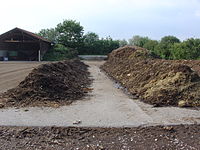
Photo from wikipedia
The present work demonstrates the use of Cd2+ as a reactivity probe of the fulvic acids (FAs), humic acids (HAs) and dissolved organic matter (DOM) compost extracts. Significant differences were… Click to show full abstract
The present work demonstrates the use of Cd2+ as a reactivity probe of the fulvic acids (FAs), humic acids (HAs) and dissolved organic matter (DOM) compost extracts. Significant differences were observed between the extracts, with the HA extract showing the highest reactivity. Comparing the different composts, the largest reactivity variation was again observed for HA then FA and finally DOM extracts. The Cd2+ binding extent was used to calculate the quality of composts and compared with a reference of uncomposted organic fertiliser (FLW), leading to the definition of an operational scale of compost quality. The parameter equivalent mass of fertiliser (mEF) was used for this scale sorted the seven composts from 0.353 to 1.09 kg FLW, for compost of sewage sludge (CSS) and vermicompost of domestic waste (CVDW), respectively. The significance of this parameter was verified through a correlation analysis between binding extent and the effect of compost application on lettuce crop growth in a field trial. The results demonstrate the potentiality of FA and HA extracts as markers of compost bioactivity and the use of Cd2+ as a reactivity probe.
Journal Title: Molecules
Year Published: 2023
Link to full text (if available)
Share on Social Media: Sign Up to like & get
recommendations!